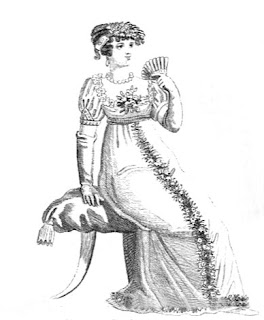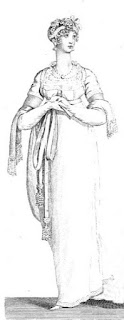This series of blogs follows the way spring fashions changed from 1806 to 1827, by looking at particular elements of fashion in three time periods: pre-Regency, Regency and the reign of George IV. My first blog is dedicated to evening wear in the pre-Regency period.
Spring 1806
 |
| Parisian complete full dress from La Belle Assemblée (Feb 1806) |
Spring 1807
 |
| Ball dress from La Belle Assemblée (Feb 1807) |
“India shawl, a deep amber colour, with a rich and variegated fringe and border, negligently drawn through each arm, so as to form a flowing drapery on the right side of the figure.”
A tucker was a ruffle attached to the neck of a gown to infill the neckline for a more modest look.
Spring 1810
 |
| Evening dress from La Belle Assemblée (Feb 1810) |
The second figure wears an “India muslin train over a white satin petticoat. A bodice of green velvet, ornamented at the seams with gold braiding, and trimmed round the neck with a twill of green crape or velvet.”
Twill is a fabric known for its diagonal weave.
My observations
The predominant colour of all these dresses is white. The gowns relied upon the trimmings and accessories and, in one case, the bodice, to bring colour to the outfits. The earlier two plates show short sleeves and long gloves; by 1810, the sleeves were long. The dresses are in the Empire style, with high waistlines and the material falling loosely below.
Sources used include:
Bell, John, La Belle Assemblée, various (1806-1810)

thank you so much
ReplyDeleteThank you so much for the excellent costume descriptions. I need a ball gown (full dress) for 1807 late spring dance in romance sequel I am working on. Perfect!
ReplyDeleteI am so glad that you found this post helpful. Happy writing. :)
Delete